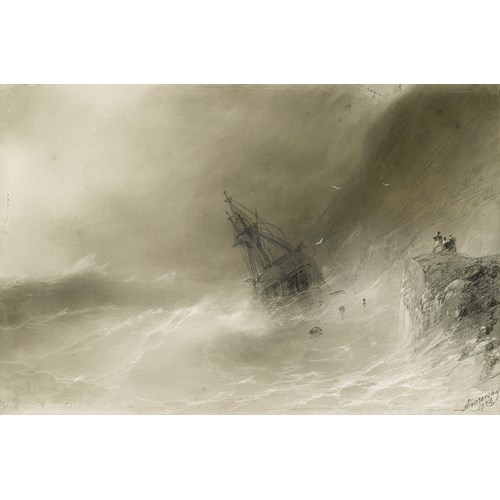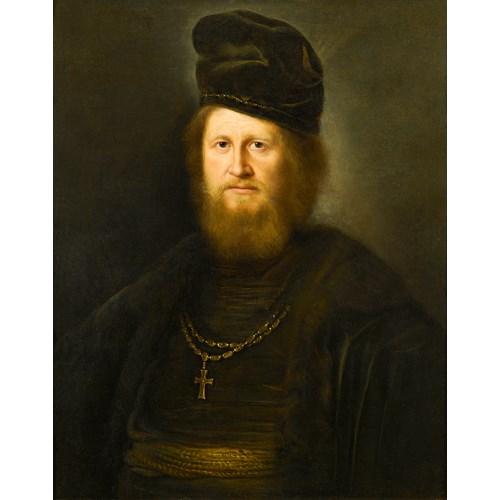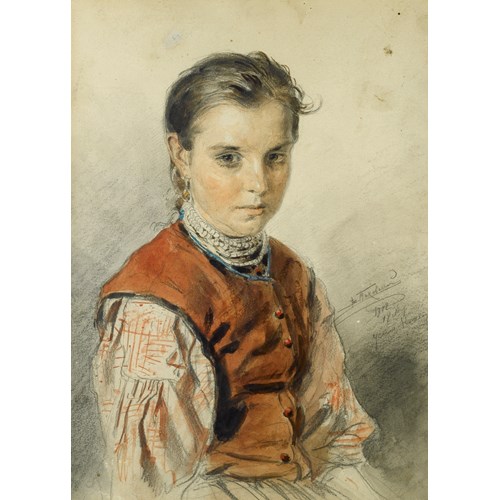Marketplace
A Wooded Landscape with a Shepherd and his Herd on a Path near a Puddle
Jan Hackaert
A Wooded Landscape with a Shepherd and his Herd on a Path near a Puddle
Epoque 1600-1750, 17th century
Origine The Netherlands
Medium Oil on canvas
Dimension 79.7 x 96.4 cm (31³/₈ x 38 inches)
Typical of Jan Hackaert’s work, this wooded landscape presents an excellent example of the artist’s consummate skill in rendering the natural world. The soft dusky sky is reflected in a glassy puddle and the carefully arranged trees which flank the path on which a solitary shepherd chivvies his flock, opens up an impressive vista of space. In the distance, blue tinged mountains, possibly based on the Swiss Alps with which the artist was familiar, can be glimpsed.
A harmonious composition is achieved by Hackaert’s artful arrangement of slender and graceful trees which almost absorb the golden summer twilight, highlighting in silver their trunks and delicate foliage. Like many of his compositions, including a work in the Hermitage, Deer Hunt, Hackaert often made use of a sous-bois mode of composition. This ordinarily involved painting the underside of the leafy canopy of trees which has the effect of drawing the viewer into the forest itself. In the present work, the two carefully constructed avenues of trees at once focus attention on the red-clad shepherd with his flock. Up lit from behind, two dogs can be seen capering about the feet of the sheep.
Hackaert was a Dutch painter, draughtsman and etcher who specialised particularly in Italianate landscapes and woodland scenes; A Wooded Landscape with a Shepherd and his Herd is a fine example of the latter category. Influenced greatly by the respective styles of Dutch Italiante artists such as Jan Both (c.1610-1652) and Jan Asselijn (c.1615-1652), Hackaert’s exceptional treatment of colour owes much to these two predecessors.
Between 1653 and 1656, Hackaert is known to have visited Switzerland several times and interestingly, not Italy, despite long held suspicions to the contrary. Whilst in Switzerland, he made several large topographical drawings for a multi-volume atlas compiled by Laurens van der Herm, an Austrian lawyer who commissioned such views from several artists.
In his landscape paintings, Hackaert often collaborated with other artists such as Johannes Lingelbach (1622-1674) and Nicholaes Berchem who executed the staffage for some of his works. Hackaert’s forest landscapes with hunting scenes, such as the Hermitage’s Deer Hunt were incredibly popular on the contemporary art market, largely because they reflected the prosperity and affluent leisure pursuits, real or coveted, of their prospective buyers.
As well as the Swiss topographical drawings, Hackaert made several other drawings in the style of Jan Both, some of whose works he owned and copied. These drawings are sketchier, broader and lighter in execution than his topographical work. Seven etchings by him are also known, all showing northern European landscapes. According to Hofstede de Groot (see Literature), Hackaert’s latest signed work dates from 1685, in which year, or soon after, he is assumed to have died.
A harmonious composition is achieved by Hackaert’s artful arrangement of slender and graceful trees which almost absorb the golden summer twilight, highlighting in silver their trunks and delicate foliage. Like many of his compositions, including a work in the Hermitage, Deer Hunt, Hackaert often made use of a sous-bois mode of composition. This ordinarily involved painting the underside of the leafy canopy of trees which has the effect of drawing the viewer into the forest itself. In the present work, the two carefully constructed avenues of trees at once focus attention on the red-clad shepherd with his flock. Up lit from behind, two dogs can be seen capering about the feet of the sheep.
Hackaert was a Dutch painter, draughtsman and etcher who specialised particularly in Italianate landscapes and woodland scenes; A Wooded Landscape with a Shepherd and his Herd is a fine example of the latter category. Influenced greatly by the respective styles of Dutch Italiante artists such as Jan Both (c.1610-1652) and Jan Asselijn (c.1615-1652), Hackaert’s exceptional treatment of colour owes much to these two predecessors.
Between 1653 and 1656, Hackaert is known to have visited Switzerland several times and interestingly, not Italy, despite long held suspicions to the contrary. Whilst in Switzerland, he made several large topographical drawings for a multi-volume atlas compiled by Laurens van der Herm, an Austrian lawyer who commissioned such views from several artists.
In his landscape paintings, Hackaert often collaborated with other artists such as Johannes Lingelbach (1622-1674) and Nicholaes Berchem who executed the staffage for some of his works. Hackaert’s forest landscapes with hunting scenes, such as the Hermitage’s Deer Hunt were incredibly popular on the contemporary art market, largely because they reflected the prosperity and affluent leisure pursuits, real or coveted, of their prospective buyers.
As well as the Swiss topographical drawings, Hackaert made several other drawings in the style of Jan Both, some of whose works he owned and copied. These drawings are sketchier, broader and lighter in execution than his topographical work. Seven etchings by him are also known, all showing northern European landscapes. According to Hofstede de Groot (see Literature), Hackaert’s latest signed work dates from 1685, in which year, or soon after, he is assumed to have died.
Epoque: 1600-1750, 17th century
Origine: The Netherlands
Medium: Oil on canvas
Signature: Signed 'HACKART.' (lower right)
Dimension: 79.7 x 96.4 cm (31³/₈ x 38 inches)
Provenance: Von Grolman, Wiesbaden, by 1900.
Literature: C. Hofstede de Groot, Beschreibendes und kritisches Verzeichnis der Werke..., vol. IX, Esslingen/Paris 1926, p. 25, no. 92.
Plus d'œuvres d'art de la Galerie









